

Libraries as Literacy Leaders — National Education Summit. Literacy is one of the core goals of education, and school libraries are uniquely positioned to provide leadership in literacy promotion to their educational community.

Literacy features prominently in many schools’ educational planning, however, the school library may not explicitly be part of the literacy strategy. Research shows that student engagement with recreational literacy or reading for pleasure peaks at the end of primary school and drops off over the high school years (Cullinan 2000), (National Literacy Trust, 2020). These are also the years when students are required to engage with increasingly complex reading and writing tasks. Reading for pleasure is consistently linked to improved literacy outcomes (Krashen, 2004), (National Literacy Trust, 2006), and is a key component of fostering literate, capable students. The Power of Reading - Stephen Krashen. Home - Books and Reading - LibGuides at Xavier College.
3 Alternatives to Reading Logs. Yarra Plenty Regional Library. School libraries fostering children's literacy and literature learning: mitigating the barriers - Merga - - Literacy. Introduction While research suggests that both the presence of school libraries and qualified school librarians can have a positive influence on children's literacy attainment (Barrett, 2010; Hughes et al., 2014; Lance & Kachel, 2018; Todd & Kuhlthau, 2005), very little consideration is given to the educative role of librarians in schools.
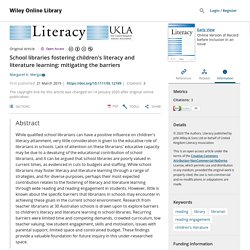
For example, Cremin and Swann (2017) note that “there is scant research focused upon the interaction patterns of school librarians, the ways in which they position themselves in reading groups and their roles in enhancing reader engagement” (p. 120). While the presence of qualified school librarians is more consistently and strongly associated with literacy benefit than the presence of unqualified staff (Lance & Kachel, 2018), across international contexts, there are varying qualifications required for registration and/or recognition of qualified school librarian status (Lupton, 2016). Methods Limited time and competing demands Time. Crowded curriculum. 'Sense of urgency': One school's bold plan to get teenagers reading. Reading fiction 'boosts pupils’ learning by 10 months' The benefits of reading for pupils' overall attainment are well known, but does it matter what children are reading?

According to an analysis published today, some books are more effective than others – and reading fiction yields far more benefits for pupils than other forms of reading material. Research: London students do less well in Pisa rankings than GCSE Opinion: Non-fiction boosts progress in reading… That’s a fact Quick read: Literacy: the real story on non-fiction Using data drawn from the Organisation for Economic Cooperation and Development’s Programme for International Student Assessment (Pisa) study, researchers have linked the frequency with which 15-year-olds read different types of reading material to their Pisa reading scores. The researchers found that pupils who frequently read newspapers, magazines, comics and non-fiction books did not achieve significantly higher Pisa scores in reading than those who did not. How to write a book review. Helping students choose books for reading pleasure.
It's only in a library that all children of all backgrounds can freely explore the huge range of books and where they have the freedom to find their own tastes and discover literature at their own pace. — Ursula Dubosarsky, SCIS Connections, May 2014 The school library can do a lot to scaffold students as they look for their just right books.

Along with an inclusive, appealing, current and wide ranging collection, you also need: a reader-friendly environment using clear, helpful signage and attractive displays with plenty of face-out display of book covers junior fiction books arranged by series to encourage reading mileage and confidence clear, helpful signage and labels displays on themes, topical issues, new books, read-alikes photos of readers and their reading recommendations. Also look into arranging fiction by genre. How to Help Students Develop a Love of Reading. Motivating Middle School Students to Read More. A MiddleWeb Blog “I don’t read.”
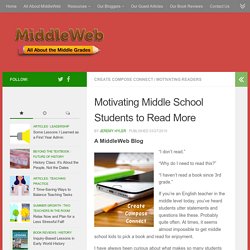
“Why do I need to read this?” Developing and Nurturing a School-Wide Culture of Reading. Readers Recommend. This is reading promotion idea that's inexpensive, low-tech, includes student voice, and I totally nabbed it from the amazing Librarian Tiff five years ago and I still love it! It's kind of what you can call an oldie but a goodie. I don't put this display out at the beginning of the school year. I've found that it's good to bring it out mid-year or connected to a reading promotion lesson activity like Speed Dating with Books to generate interest. Shockingly, it seems that my middle schoolers respond to "new" things, so I bring this out in the lull between Winter and Spring break.
But this can work at any time in a school library or ELA classroom. It's kinda like a low-tech YELP review for books! I was inspired by Librarian tiff because she also does this in her school library and created this amazing graphic below, made it Creative Commons, and gave it out to the world! The Benefits of Reading Aloud to Middle School Students. By the time many students reach middle school, they no longer have books read aloud to them at home or at school. But research shows benefits of hearing books read aloud, including improved comprehension, reduced stress, and expanded exposure to different types of materials. For five minutes of each class period, I read aloud to my middle school students. I’m often asked how I “give up time” each day to read, but the five minutes are a gift to my students. Spending this time each day enriches the classroom community, allows me to share a love of reading, enhances my language arts instruction, and exposes students to new authors, genres, and themes.
Enriching Classroom Community. A4: Every summer we run a staff book club. We read a YA novel in June and a "normal. What Is a Book Talk?: Your Guide to Making Them Work in the Classroom. You want your students to read more, but the books aren’t exactly flying off the classroom bookshelves.

A book talk may be just the tool you need to engage your students in a new book. A book talk could sell your students on the idea of picking up a new title or author or give them the push they need to find a book they love and convince their peers to read it. [📷: Top image by mrs. _cronk on Instagram.] Promotion of a Reading Culture. Image by StockSnap from Pixabay.
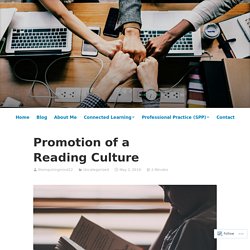
Podcast: Building a school reading culture. This podcast is proudly supported by QUT Podclass.
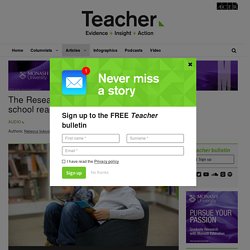
A brand new series of free podcasts, hosted by Madonna King, developed for everyone who is passionate about teaching. Exploring topics like managing your career development through to creating greater engagement in the classroom. All with a real world focus. Search QUT Teacher Podclass to listen today. Build a Reading Culture – Pete the Librarian. I asked teacher-librarians for their favourite and most effective ideas to build a strong reading culture in schools. The response was overwhelming, and I’ve collated the ideas under six categories: Reading, Events, Programs, Relationships, Students and Environment. Books for Your Tweens and Teens - Children's Books Daily... I’ve been collecting books for tweens and teens on *all of the things* for many years now – for the various schools I have worked at and now also for my own children.
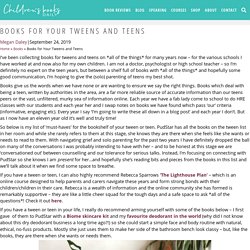
I am not a doctor, psychologist or high school teacher – so I’m definitely no expert on the teen years, but between a shelf full of books with *all of the things* and hopefully some good communication, I’m hoping to give the (solo) parenting of teens my best shot. Books give us the words when we have none or are wanting to ensure we say the right things. Books which deal with being a teen, written by authorities in the area, are a far more reliable source of accurate information than our teens peers or the vast, unfiltered, murky sea of information online. 10 ways to get the most out of silent reading in schools. Services to Schools. It may take a few tries to find the best approach for you and your students. Be creative, keep the lines of communication open and be prepared to make changes as needed. Here are a few approaches that have worked for other schools. What to read Choosing what to read is a great discussion in itself.
Everyone in the club could: read the same book and discuss it together read a book from the same genre / based around the same theme / by the same author and tell each other about it (without spoilers!) 2015 Summit Resources. Booktalk Basics and Beyond: Transforming Reading Culture by Empowering Student Voices Revamp the way your students talk to each other about books!
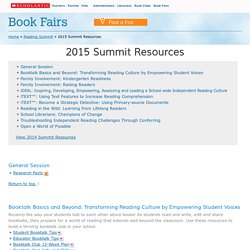
As students read and write, edit and share booktalks, they prepare for a world of reading that extends well beyond the classroom. Use these resources to build a thriving booktalk club in your school. Family Involvement: Kindergarten Readiness Prepare families as their children transition into kindergarten. Family Involvement: Raising Readers.